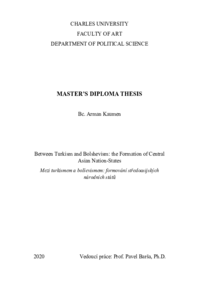Between Turkism and Bolshevism: the Formation of Central Asian Nation-States
Mezi turkismem a bolševismem: formování středoasijských národních států
diplomová práce (OBHÁJENO)

Zobrazit/
Trvalý odkaz
http://hdl.handle.net/20.500.11956/122953Identifikátory
SIS: 219899
Kolekce
- Kvalifikační práce [24991]
Autor
Vedoucí práce
Oponent práce
Slačálek, Ondřej
Fakulta / součást
Filozofická fakulta
Obor
Politické teorie
Katedra / ústav / klinika
Ústav politologie
Datum obhajoby
9. 9. 2020
Nakladatel
Univerzita Karlova, Filozofická fakultaJazyk
Angličtina
Známka
Velmi dobře
Klíčová slova (česky)
Centrální Asie|bolševismus|nacionalismus|turkismus|národní státyKlíčová slova (anglicky)
Central Asia|Bolshevism|nationalism|Turkism|nation-statesCílem teto práce je analyzovat proces formování národních států v Centrální Asii převážně během druhé poloviny devatenáctého a první čtvrtiny dvacátého století. Významnou roli v tomto procesu totiž sehrály, kromě sovětského vlivu, i lokální elity (jako Alaš Orda a džadídové) a představitelé carismu. Pro lepší pochopení dané problematiky je proto nutné porozumět vzájemným vztahům mezi těmito klíčovými aktéry. Klíčová slova Centrální Asie, bolševismus, nacionalismus, turkismus, národní státy
The main goal of this paper is to trace the formation of nation-states in Central Asia, primarily during the second half of the 19th and the first quarter of the 20th century. Although soviets played a significant role in shaping modern Central Asian political map, local national elites (like Alash Orda and jadids) and tsarist officials had contributed to this process as well. Thus, it is necessary to understand the interrelationship between all these key actors. Key words Central Asia, Bolshevism, nationalism, Turkism, nation-states
